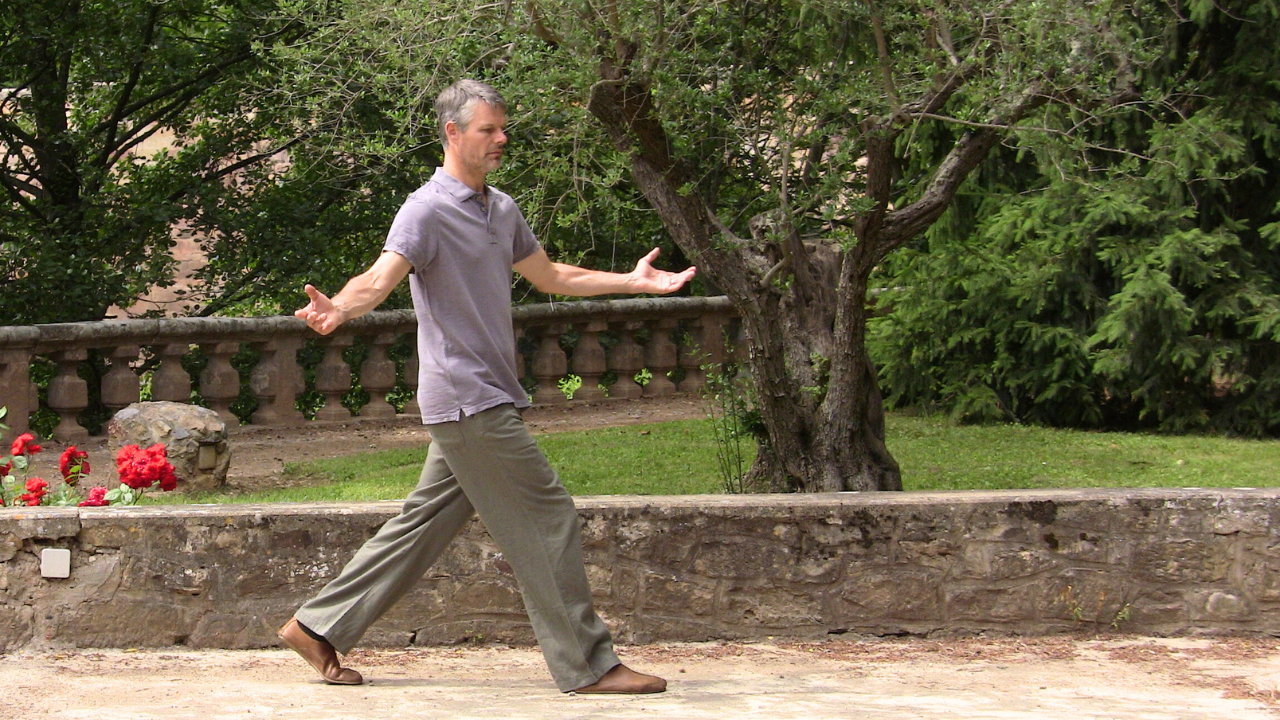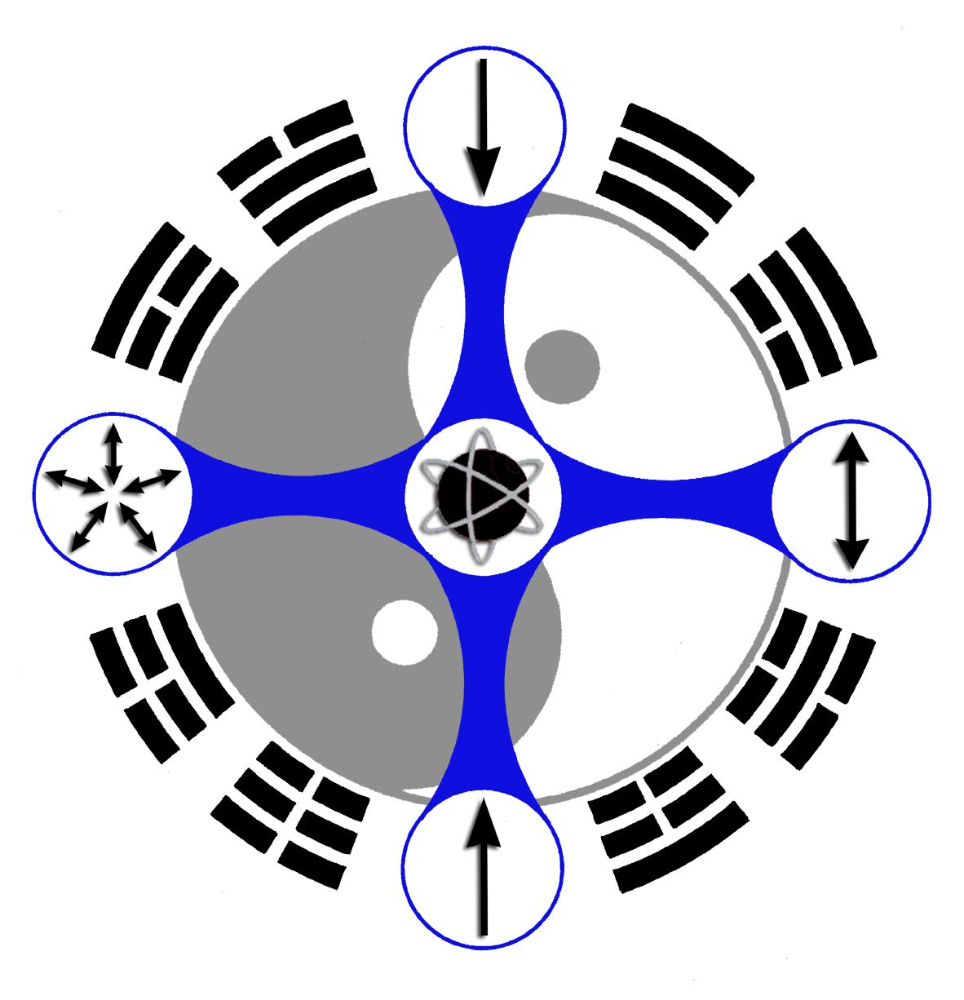Circle Walking to Energise Your Body, Mind and Qi
Apr 25, 2024

By Paul Cavel
Most internal arts have a specific learning progression, which begins with a set of six or more movements in qigong, and up to 108 moves in tai chi. Then, as you practise the form over weeks, months and years, you sink into your body, mind and qi by adding layers of internal content to the form.
Bagua is different.
Circle Walking, bagua's foundational technique, can be learned in a single course and begin having a positive impact on your body, mind and qi from the outset.
More on the Outside, Less on the Inside
Like all internal arts, bagua's methodology adheres to the source material from which the Tai Chi Classics came, including:
“More on the outside, less on the inside; less on the outside, more on the inside”.
That is to say, when practising complex forms, the mind too easily becomes preoccupied with:
-
The motion of the hands – either in tandem with or opposite to one another.
-
The motions of the body and legs, such as stepping techniques, and direction or orientation changes.
-
How everything is synchronised into one, seamless flow.
Focusing on choreography distracts the mind from concentrating on depth, content and quality of internal techniques.
Circle Walking requires less mind space since the only choreography is Mud Stepping and how to change direction while walking in a circle. Early on, beginners can concentrate on content, the internals that create the associated benefits for which the internal arts are famous: these include deep relaxation, improved blood and qi circulation, better balance and more flexibility, strength and power.
Circle Walking is not only a means for quicker access to health benefits, but also, due to its yang nature, holds the potential to take a practitioner further down the road of personal development. Each internal art is a vehicle through which the practitioner accesses their insides for transformation, health, vitality, emotional balance, peace of mind and longevity. Every vehicle has specialties and limitations, but of course these are only potentials since how well they actually perform comes down to the skill of the driver, how much they can utilise the vehicle's features and how well the two integrate. A highly trained racing car driver in a sedan car can beat the average driver in a racing car; but when the trained driver gets behind the wheel of a supped-up car, the true potential is unlocked and can be realised.
This vehicle (practice)-driver (practitioner) relationship is very important to accessing any or all of the potential benefits from any kind of training. Bagua, through its yang methodology and natural philosophy, offers a vehicle of outstanding quality, which can take a practitioner to the absolute pinnacle of their ability.
But all of that potential must be unlocked through regular, diligent and sustained practice since you cannot simply buy the vehicle.
Dredging Through Mud
Again, the foundation of bagua is Mud Stepping, which is very different to everyday walking because the feet are:
-
Lifted rather than peeled off the ground, heel then toe; and
-
Land flat rather than heel to toe.
In Mud Stepping, the soles of the feet remain horizontal throughout the walking process, which in turn pressurises and opens up the lower organ base, spine, legs and feet – when done correctly, that is. Also, the body’s weight is either fully on one leg or the other during walking with a clear 100-percent weight shift in the middle. This stabilises the spine and torso, and maximises the closings and openings of the body. This walking methodology essentially transforms the whole body into a unified hydraulic pump that circulates blood and qi, creating a powerful detoxification process that is stronger and fuller than any form of qigong or tai chi.
Mud Stepping earns its name for the way in which you keep all your weight on your back leg, while extending the foot and knee of the front leg forwards to stretch open the body, externally and internally. The application of the intent is similar to what would be required to push your foot and shin through deep, sloppy mud. There is a sense of resistance in the advancing leg, which takes effort to counter and, therefore, develops great strength and power. This is why Mud Stepping is the bedrock of bagua and, over time, completely transforms your everyday walking.
No, you don't walk through town Mud Stepping (as you would most certainly attract the wrong kind of attention), but certain internal aspects seep into your gait – e.g. finely-honed alignments, bending and stretching of the soft tissues, and opening and closing of the joints. The outcome is nowhere near as deep or as powerful as Mud Stepping itself, but keeps the legs healthy and alive with every step you take.
Art of Change
Once the basic Mud Step is in place, the next phase is to Walk the Circle and periodically change direction. The act of walking in a circle twists the soft tissues of the legs in and out rhythmically, with the inside leg naturally twisting more that than the outside leg. Balance is restored by walking equally in both directions. Circle Walking also helps to generate a continuum in motion as there is no stopping and starting; changing direction is just a bigger twisting of the leg tissues to carry you around and into the opposite direction.
When you get a good handle on Walking the Circle, the last major piece of the foundation of bagua is brought into play: palm postures. Palm postures are specific shapes that are created with the arms and hands that stretch open all the soft tissues and joints of the hands, arms, shoulders – and when done well – the upper spine, ribcage and upper organs.
There are over 200 palm postures, each designed to open up specific parts of the soft tissues and energy channels in the upper body. A set of eight or 12 that target the main areas of the torso and arms to progressively open up the upper body will suffice most practitioner’s needs. Walking mainly affects the lower body, while palm postures affect the upper body by connecting the tissues of the torso, spine and various energy channels to amplify all the positive benefits of Taoist neigong.
As you build up your skill, you want to increase both:
-
The speed of your walk to engage aerobic exercise.
-
The length of your practice time to deeply flush the fluids throughout the body and bathe yourself in life-sustaining qi.
Total Transformation in Body, Mind and Qi
When trained correctly, Circle Walking, slowly, over the months and years of practice, can totally transform your body, mind and qi, generating health, vitality and even fitness. Making the body fit is not a prime directive of tai chi or qigong training. Circle Walking is capable of containing the bulk of the Taoist meditation tradition of Old Taoism, elevating your practice to the genuine realm of spiritual development to enhance the powers of the Mind.
All of these enticing and exciting carrots don't come cheap. They require dedication, effort and perseverance, without exceeding your natural capacity. Circle Walking is firmly rooted in the Water Method, which aims to bring balance to all aspects of the body, energy and mind. The yang method of bagua, fused with the yin way of Water (energy) produces a cultivated practice of incredible character that ultimately becomes intertwined within the personality of the practitioner.
Join a course — online or in person — to learn how the Water Method can help you overcome physical, energetic, emotional and mental traumas, to become stronger and feel more alive!

